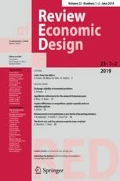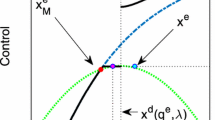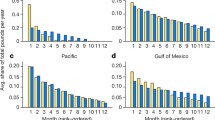Abstract
We study contests in which fishers (or players), in a fishery managed under a catch-share program, compete over catch shares by expending irreversible effort, and the fishery manager, influenced by the players’ effort, allocates their catch shares. We first show that the number of active players and their identities in each period depend only on the players’ marginal costs, and they remain exactly the same across all periods. Then, we show that, in each period, an active player with a lower marginal cost expends greater effort and secures a greater catch share than a player with a higher marginal cost. We also show that a player who expends zero effort due to his relatively high marginal cost ends up with a less and less catch share over time.
Similar content being viewed by others
Notes
In the literature on contests, a contest is defined as a situation in which players compete by expending effort to win a prize. Examples include rent-seeking contests, environmental conflicts, and litigation. See, for example, Tullock (1980), Hillman and Riley (1989), Corchón (2007), Epstein and Nitzan (2007), Congleton et al. (2008), and Konrad (2009).
Bergland et al. (2001) study rent-seeking behavior among agents who compete for high future shares of a common natural resource. In particular, they present a model which shows how fishers influence the government through rent-seeking behavior when they know that their industry will be regulated. Bergland et al. (2001) study fishers’ rent-seeking behavior, before the regulation is implemented, to increase their initial catch shares. In the current paper, however, we study a dynamic contest in which a fishery manager initially allocates equal catch shares, and fishers compete over catch shares, in each period of time, by expending irreversible effort.
Effort here may represent: (i) individual fishers’ investments in the fishery, such as investments in new vessels and investments in vessel length and capacity; (ii) fishers’ contributions (in various forms) to the development and sustainability of the fishery; (iii) their outlays to settle disputes over (proposed) catch shares; (iv) fishers’ lobbying expenditures to have the fishery manager adopt an allocation method that would increase their catch shares; and/or (v) bribes paid to the fishery manager or the government officials. Note that most of such effort would be unproductive, and would be viewed as social costs that reduce economic efficiency.
However, effort or resources spent to compete over catch shares may reduce economic efficiency. For example, individual fishers’ investments in new vessels or to increase vessel length and capacity may lead to overcapitalization and reduce economic efficiency. In addition, as mentioned in footnote 3, settlement costs of disputes over catch shares, lobbying expenditures, and bribes may also reduce economic efficiency. See Bergland et al. (2001) for other examples of rent-seeking activities in fisheries which may generate economic inefficiency.
See Bonzon et al. (2010) for how to set the catch limit in reality.
Clark et al. (2020) considers a model in which players compete in two interlinked sequential contests and the winner of the first contest has higher productivity of effort than the others in the second period.
This assumption may be justified by the following possibilities. First, the fishery manager can simply require each player to make a catch equal to his catch share. Second, the fishery-wide catch limit is small relative to the market size, so that each player’s “optimal” catch is greater than his catch share.
Note first that, as in Baik and Jung (2019), neither the action profile in which every player expends zero effort nor an action profile in which only one player expends positive effort is an equilibrium of the subgame.
Note that, in a standard quantity-setting oligopoly with homogeneous products, a firm with a lower constant marginal cost produces a greater output level than a firm with a higher constant marginal cost (see Vives 1999, pp. 96–101).
Consider the case where \(n-1\) players except player 1 have the same marginal cost. In this case, the players except player 1 choose, in each period, the same positive effort level, which is less than player 1’s effort level. Hence, we obtain the following. First, player 1’s fractional catch share in period 1 is greater than 1/n, but every other players’ fractional catch share in period 1 is less than 1/n. Second, in the case where \(0< \theta <1\), we have: \(s_{11}^*< s_{12}^*\) and \(s_{j1}^*> s_{j2}^*\) for \(j \in N {\setminus } \{1\}\). Third, in the case where \(\theta =1\), we have: \(s_{i1}^*=s_{i2}^*\) for \(i \in N\).
Note that, under the assumptions in Sect. 2, the consumer surplus in each period does not change, regardless of the value of the parameter \(\theta \).
References
Ansink E (2011) The Arctic scramble: introducing claims in a contest model. Eur J Polit Econ 27(4):693–707
Baik KH, Jung HM (2019) Asymmetric contests with initial probabilities of winning. Int J Econ Theory 15(4):385–98
Bergland H, Clark DJ, Pederson PA (2001) Rent seeking and the regulation of a natural resource. Mar Resour Econ 16(3):219–33
Bonzon K, McIlwain K, Strauss CK, Van Leuvan T (2010) Catch share design manual: a guide for managers and fishermen. Environmental Defence Fund
Clark DJ, Nilssen T, Sand JY (2020) Gaining advantage by winning contests. Rev Econ Des 24(1–2):23–38
Congleton RD, Hillman AL, Konrad KA (eds) (2008) 40 Years of research on rent seeking 1: theory of rent seeking. Springer-Verlag, Berlin
Corchón LC (2007) The theory of contests: a survey. Rev Econ Des 11(2):69–100
Costello C, Gaines SD, John L (2008) Can catch shares prevent fisheries collapse? Science 321(5896):1678–81
Epstein GS, Nitzan S (2007) Endogenous public policy and contests. Springer-Verlag, Berlin
Faith RL, Goff BL, Tollison RD (2008) Bequests, sibling rivalry, and rent seeking. Public Choice 136(3–4):397–409
Hillman AL, Riley JG (1989) Politically contestable rents and transfers. Econ Polit 1(1):17–39
Konrad KA (2009) Strategy and dynamics in contests. Oxford University Press, New York
Lynham J (2014) How have catch shares been allocated? Mar Policy 44:42–48
Tullock G (1980) Efficient rent seeking. In: Tullock G, Buchanan JM, Tollison RD (eds) Toward a theory of the rent-seeking society. A&M University Press, College Station, pp 97–112
Vives X (1999) Oligopoly pricing: old ideas and new tools. MIT Press, Cambridge
Yildirim H (2007) Proposal power and majority rule in multilateral bargaining with costly recognition. J Econ Theory 136(1):167–96
Yildirim H (2010) Distribution of surplus in sequential bargaining with endogenous recognition. Public Choice 142(1–2):41–57
Author information
Authors and Affiliations
Corresponding author
Additional information
Publisher's Note
Springer Nature remains neutral with regard to jurisdictional claims in published maps and institutional affiliations.
We are grateful to Chris Baik, two anonymous referees, the Associate Editor in charge of the paper, and the Editor-in-Chief of the journal, Huseyin Yildirim, for their helpful comments and suggestions.
Appendices
Appendix A: The sign of \(\partial \pi ^*/\partial \theta \)
Let \(Z=\sum \nolimits _{k \in N^*} (G_k^2/H_k)-\sum \nolimits _{j \in N}(p-c_j)/n\). Since the term \(\{ 1+2\delta (1-\theta )\}\) in (12) is always positive, the sign of \(\partial \pi ^* / \partial \theta \) is the same as the sign of Z.
Consider the case where \(c_1 < c_j =c\) for \(j=2, \ldots , n\). In this case, we have that \(n^*=n\). It is straightforward to obtain
Let \(B=p-c\). Then we have that \(p-c_1= \lambda (p-c)=\lambda B\), where \(\lambda >1\). We can then rewrite (A1) as
It is straightforward to see that the sign of Z is the same as the sign of \(Z_1\):
Appendix B: Analysis of the game with multiple periods
In this appendix, we analyze the game with multiple periods presented in Sect. 4. To obtain outcomes associated with an SPNE of the game, we work backward. We first analyze the proper subgames starting at the beginning of period T, then look at the strategic interaction among the players in period \(T-1\), then in period \(T-2\), and so on.
Let \(x_{it}^e\), for \(i \in N\) and for \(t=1, \ldots , T\), denote player i’s effort level in period t in the equilibrium of the \((s_{1t-1}, \ldots , s_{nt-1})\) subgame starting at the beginning of period t. Let \(\mathbf {x_t^e} \equiv (x_{1t}^e, \ldots , x_{nt}^e)\) for \(t=1, \ldots , T\).
In period T, knowing his fractional catch share granted in period \(T-1\), player i, for \(i \in N\), seeks to maximize his payoff \(\pi _i^T\) over his effort level \(x_{iT}\), given his belief about the other players’ effort levels in period T:
In period \(T-1\), knowing his fractional catch share in period \(T-2\), player i, for \(i \in N\), seeks to maximize his payoff \(\pi _i^{T-1}\) over his effort level \(x_{iT-1}\), given his belief about the other players’ effort levels in period \(T-1\):
where \(R_i^{T-1} = \delta \{ (p-c_i)\theta f_i(\mathbf {x_T^e})Q -x_{iT}^e \}\). It is straightforward to see that \(R_i^{T-1}\) does not depend on \(x_{iT-1}\), and is nonnegative.
In period \(T-2\), knowing his fractional catch share granted in period \(T-3\), player i, for \( i\in N\), seeks to maximize his payoff \(\pi _i^{T-2}\) over his effort level \(x_{iT-2}\), given his belief about the other players’ effort levels in period \(T-2\):
where \(R_i^{T-2}=\delta \{ (p-c_i)\theta f_i(\mathbf {x_{T-1}^e})Q-x_{iT-1}^e\} + \delta ^2(p-c_i)(1-\theta )\theta f_i(\mathbf {x_{T-1}^e})Q + \delta ^2 \{ (p-c_i)\theta f_i(\mathbf {x_T^e})Q-x_{iT}^e\}\). It is straightforward to see that \(R_i^{T-2}\) does not depend on \(x_{iT-2}\), and is nonnegative.
Similarly, in period t, for \(t=2, \ldots , T-3\), knowing his fractional catch share granted in period \(t-1\), player i, for \(i \in N\), seeks to maximize his payoff \(\pi _i^t\) over his effort level \(x_{it}\), given his belief about the other players’ effort levels in period t:
where \(R_i^t\) is the sum of the terms which do not depend on \(x_{it}\). It is straightforward to see that \(R_i^t\) is nonnegative.
In period 1, knowing his initial (fractional) catch share, player i, for \(i \in N\), seeks to maximize his overall payoff \(\pi _i^1\) over his effort level \(x_{i1}\), given his belief about the other players’ effort levels in period 1:
where \(R_i^1\) is the sum of the terms which do not depend on \(x_{i1}\). It is straightforward to see that \(R_i^1\) is nonnegative.
Note that \(\pi _i^t\), for \(t=1, \ldots , T\), is strictly concave in \(x_{it}\), which implies that the second-order condition for maximizing \(\pi _i^t\) is satisfied. Let \(X_t^e = \sum \limits _{j \in N} x_{jt}^e\). Player i’s effort level, \(x_{it}^e\), satisfies either (B1) or (B2):
or
Let \(n_t^e\), for \(t=1, \ldots , T\), represent the number of the active players in period t in the equilibrium of the \((s_{it-1}, \ldots , s_{nt-1})\) subgame starting at the beginning of period t. Let \(N_t^e \equiv \{ 1, \ldots , n_t^e\}\). Using (B1) and (B2), we obtain Lemma B1.
Lemma B1
-
(a)
In period t, for \(t=1, \ldots , T\), active player k chooses
$$\begin{aligned} x_{kt}^e= & {} \theta \left\{ \sum \limits _{z=t}^T \delta ^{z-t}(1-\theta )^{z-t} \right\} (n_t^e-1) [(p-c_k) \sum \limits _{j \in N_t^e} \{ 1/(p-c_j)\}\\&\quad -\, n_t^e +1]Q/(p-c_k)\left[ \sum \limits _{j \in N_t^e}\{ 1/(p-c_j)\}\right] ^2, \end{aligned}$$for \(k \in N_t^e\), where \((p-c_{n_t^e}) \sum \nolimits _{j \in N_t^e} \{ 1/(p-c_j) \}+n_t^e+1>0\).
-
(b)
In period t, player h, if any, chooses \(x_{ht}^e=0\), for \(h \in N {\setminus } N_t^e\), in which case
$$\begin{aligned} (p-c_h)\sum \limits _{j \in N_t^e} \{ 1/ (p-c_j)\} -n_t^e +1 \le 0. \end{aligned}$$ -
(c)
The total effort level of the players in period t is
$$\begin{aligned} X_t^e = \theta \left\{ \sum \limits _{z=t}^T \delta ^{z-t}(1-\theta )^{z-t}\right\} (n_t^e-1)Q/\sum \limits _{j \in N_t^e} \{ 1/(p-c_j)\}. \end{aligned}$$
Lemma B1 shows that the effort level \(x_{kt}^e\) of active player k in period t does not depend on the players’ (fractional) catch shares in period \(t-1\). This implies that it does not depend on the players’ effort levels in period \(t-1\). Lemma B1 also shows that the number of active players and their identities in period t depend only on the players’ marginal costs. Since each player has the same marginal cost in all T periods, and since an active player is determined by the same cutoff level of marginal cost in all T periods, it is straightforward to see that the number of active players and their identities remain exactly the same across all T periods.
Rights and permissions
About this article
Cite this article
Baik, K.H., Park, Y. Contests for catch shares. Rev Econ Design 26, 23–42 (2022). https://doi.org/10.1007/s10058-021-00252-9
Received:
Accepted:
Published:
Issue Date:
DOI: https://doi.org/10.1007/s10058-021-00252-9




